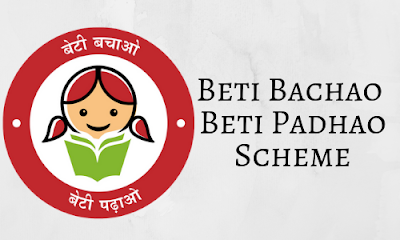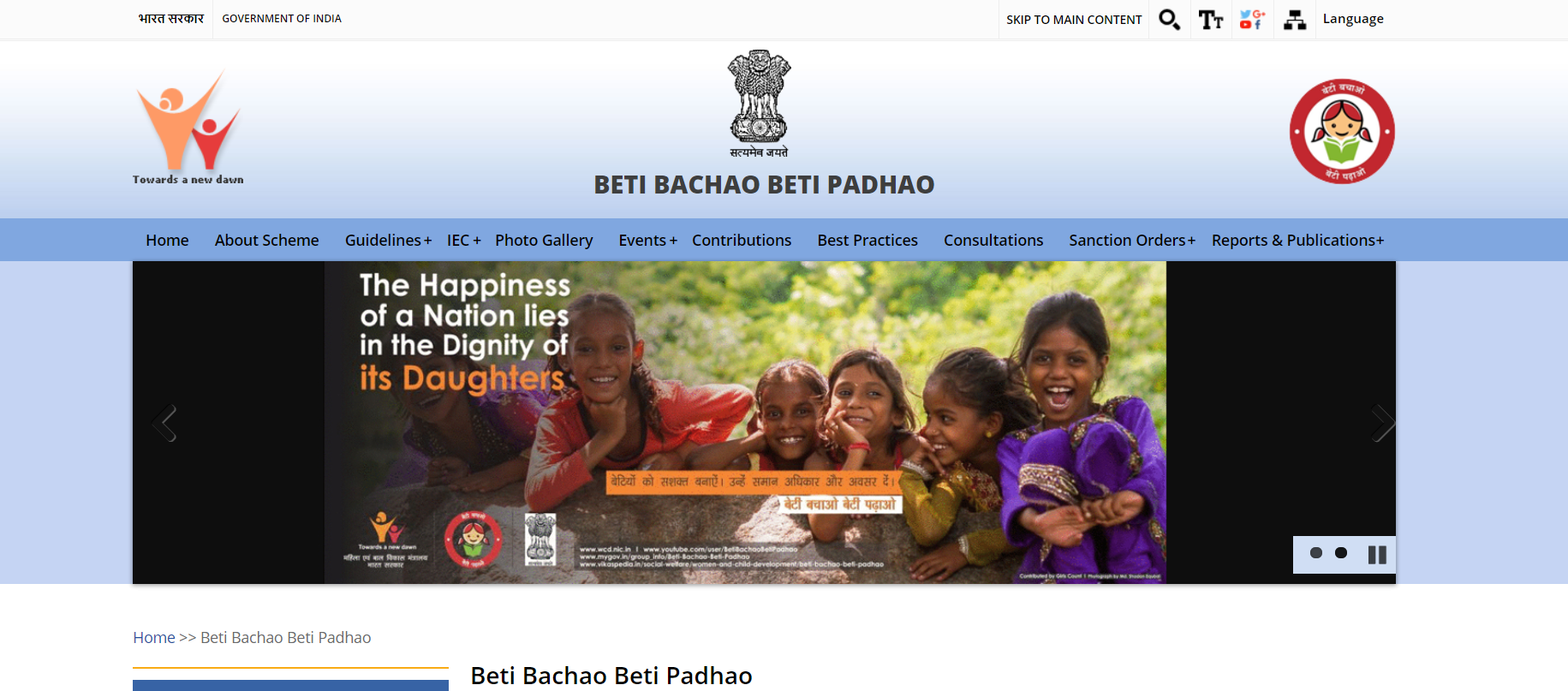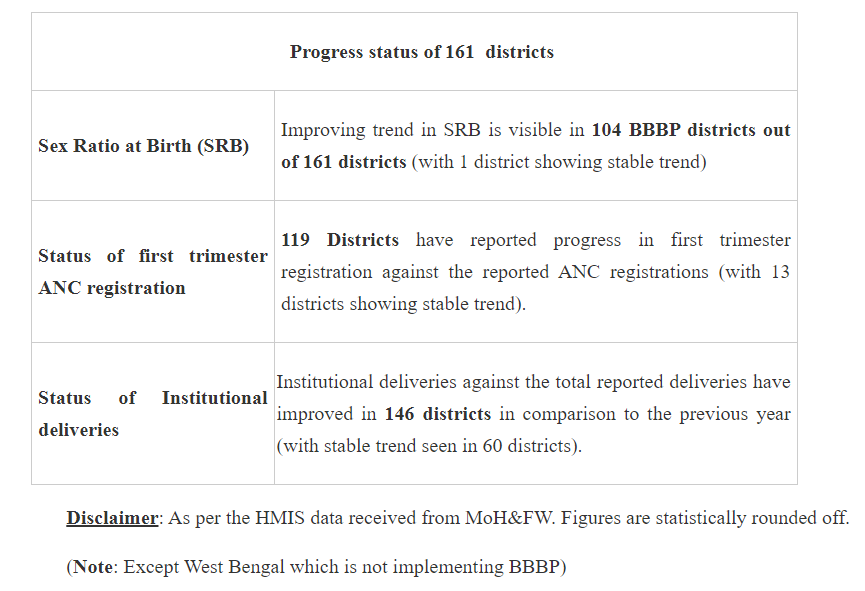Beti Bachao, Beti Padhao scheme (बेटी बचाओ बेटी पढ़ाओ) is a campaign launched by Prime Minister Narendra Modi to promote awareness regarding girl’s education and combat the declining Child Sex Ratio (CSR). It was launched with initial funding of Rs. 100 crores at Panipat, Haryana on 22 January 2015.
The BBBP scheme also carries provisions for awards and recognitions. However, there is no provision for direct individual cash transfer as it is not a Direct Benefit Transfer scheme.
To read the Beti Bachao scheme in a detailed manner, visit the official site.
Contents
Background
Indian culture has always treated women as a goddess in its ideological sense but the reality is far from this mythological concept. In reality, Indian society suffers from imbalanced gender development and skewed sex-ratio. The 2011 Census data presented a grim picture of a declining trend in the Child Sex Ratio (CSR) between 0-6 years. It was at an all-time low of 918. Furthermore, the low performance of India’s gender development for successive years on various indices of Gender equality such as the World Economic Forum’s Global Gender Gap Index displayed a worrisome trend.
It was also realized that because of the unequal participation of women in the labor force market and development sectors, India was unable to harness the true potential of the female gender.
In such a case, it became imperative for the government to promote gender development and opt for some pro-active measures for the healthy growth of girl-child. Therefore remedial steps in the form of the BBBP scheme were the need of the hour to curb the imbalanced gender development in the nation.
Functional Responsibilities
The scheme is a tri-ministerial effort of three Ministries which include the Ministry of Women and Child Development, Health & Family Welfare and Human Resource Development. Secretary of MWCD heads a national task force that administers the Beti Bachao, Beti Padhao (BBBP) scheme.
Incumbent Minister of Women and Child development is Smt. Smriti Irani.
The detailed responsibilities for each ministry have been elucidated below.
(Source- PIB)
1. Ministry of Women and Child Development
Promote registration of pregnancies in the first trimester in AnganwadiCentres (AWCs); Undertake Training of stakeholders; Community Mobilization & Sensitization; Involvement of Gender Champions; Reward & recognition of institutions & frontline workers.
2. Ministry of Health & Family Welfare
Monitor implementation of Pre-Conception and Pre-Natal Diagnostic Techniques (PCP&DT) Act, 1994; Increased institutional deliveries; Registration of births; Strengthening PNDT Cells; Setting up Monitoring Committees.
3. Ministry of Human Resource Development
Universal enrolment of girls; Decreased drop-out rate; Girl Child-friendly standards in schools; Strict implementation of Right to Education (RTE); Construction of Functional Toilets for girls.
Components
1. Media Campaign
A Nation-wide campaign using social media as a tool was launched for celebrating Girl Child and enabling girl’s education. The campaign is being carried through an integrated 360° media approach. The main focus has been laid on sensitizing the population about women’s development and saving girl child.
2. Multi-Sectoral intervention
Under the Scheme, the multi-sectoral action plan is taken up in selected districts to measure the outcomes of plans being implemented to improve the CSR. A total of 405 districts are being covered under Multi-Sectoral Intervention. Under it, a 100% Centrally Sponsored Scheme grant is provided directly to the District Magistrate/District Collector for the implementation of BBBP.
Objective
The overall theme of the Beti Bachao Beti Padhao Yojana scheme is to push the Indian society towards offering girl-child a better and safe environment to grow in. Therefore, each objective has been planned to revolve around the central them in mind only.
- To address the issue of the declining trend of Child Sex Ratio (CSR)
- To promote the development of a holistic environment for girl empowerment
- To promote girl education without any discrimination
- To prevent gender-biased sex selective elimination of girl-child and to prevent sex-selective abortion
- To put a stop on child marriage and dowry practices
- To ensure survival and protection of the girl child and eradicate evils like female foeticide and female infanticide
- To focus on Gender Critical Districts and improve their CSR.
- To celebrate the birth of girl-child and appreciate her contribution in our lives
- To break the gender Stereotypes of Indian society
Targets
- Improve the Sex Ratio at Birth (SRB) in selected gender critical districts by 2 points in a year.
- Reduce Gender gap in Under Five Child Mortality Rate from 7 points in 2014 to 1.5 points per year
- Increase Institutional Deliveries by at least 1.5 % increase per year
- Increase enrolment of girls in secondary education to 82 percent by 2018-19.
- Provide a functional toilet for girls in every school in selected districts.
- Improve the Nutrition status of girls – by reducing the number of underweight and anemic girls under 5 years of age.
- Ensure universalization of ICDS and improve girls’ attendance
- Mobilize communities to improve CSR funding and promote Girl’s education.
Popular schemes under Save Girl Educate Girl Child
To achieve the overarching objectives of the scheme, various sub-schemes have been rolled out under the BBBP scheme. Some of the major schemes are given below-
- Sukanya Samridhi Yojana
- Ladli scheme
- Kanyashree Prakalpa Yojana
- Balika Samridhi Yojana
- Ladli Laxmi Yojana
- Dhanalakshmi scheme
Making it a movement
To increase the appeal of the scheme, Olympics 2016 bronze medallist Sakshi Malik was made the brand ambassador for the BBBP scheme on 26 August 2016.
Another trending initiative on Twitter with hashtag #SelfieWithDaughter was also promoted on social media in June 2015. It began when the Sarpanch of Bibipur, Sunil Jaglan from Jind in Haryana took a selfie with his daughter Nandini.
Innovations under BBBP scheme
To make this scheme a grand success and push the cause in a true manner at ground level, District Administrations have rolled out many Innovative Activities. Some of them are given below-
- Daughter’s club (Hoshangabad, Madhya Pradesh)- To create a club of parents who have daughters in every ward/village
- Utkarsh (Una, Himachal Pradesh)- To issue Deputy Commissioner (DC) Cards to the families of girls
- Honouring Panchayats with High Sex Ratio (Kapurthala, Punjab)
- Bitiya Aur Birwa (Rewa, Madhya Pradesh)- To reward mothers for delivering baby girls
- Celebration of Beti Janam (Upper Siang, Arunachal Pradesh)- To celebrate, appreciate and value the birth of girls
- Lunch With Laadli (Jhunjhunu, Rajasthan)- To promote personality development and healthy habits to improve the nutritional and educational status of girls
- FootGal (Churachandpur, Manipur)- To generate awareness by encouraging girls to participate in sports
- ‘No’ to Child Marriage (Thiruvannamalai, Tamil Nadu)- To promote ending child marriage through a mascot, ‘Nandhini’
- Badhai Sandesh for Kanya Janmotsava (Lakhisarai, Bihar)- To promote and value the birth of girls to create an overall change in the mindset of the community
- Bal Mitra Police (Gwalior, Madhya Pradesh)- To empower girls with legal knowledge
- Adolescent Girls Club (Nagaland)- To generate awareness on menstrual hygiene, child sexual abuse, and teenage pregnancy among adolescent girls.
- Women’s Parliament (Y.S.R. Kadappa, Andhra Pradesh)- To sensitize adolescent girls and women to build a gender-sensitive society.
Access the complete PDF here.
Innovation under BBBPIn this regard, the Mansa district in Punjab also launched ‘Udaan – Sapneya Di Duniya De Rubaru‘ (Udaan- Live your Dream For One Day)’ scheme to inspire its girls to be educated. It is a unique initiative in which girls belonging to classes VI-XII are given an opportunity to spend one day with a professional they aspire to be — doctor, police official, engineer, IAS officers, among others.
Operational Coverage
The scheme was carried in three phases. In the first phase, 100 districts were identified based on the low Child Sex Ratio as per Census 2011 data.
The criteria for the selection of districts were:-
- Districts below the national average (There were 87 such districts in 23 states)
- Districts above the national average but with a declining trend (8 districts in 8 states)
- Districts above the national average but with an increasing trend (5 districts in 5 states)
Then in the second phase, the scheme was further expanded to 61 additional districts which were having CSR below 918.
Finally, on 8 March 2018, The scheme was rolled out to cover the whole Nation. BBBP was extended to become a pan-India scheme. Now it covers all the 640 districts of the country (as per census 2011). (In 2019, there are a total of 731 districts)
Presently, all States and UTs except West Bengal have constituted the State Task Force as per the guidelines of the BBBP scheme. This special task force is headed by the Chief Secretary of the state.
Success report
Due to the effective implementation of this noble scheme, the foremost change that the nation saw was that the issue of unbalanced gender development got the national limelight, The issue was not only put to center-stage but it also got the much-needed attention that it deserves.
WCD ministry’s recent data shows that due to the execution of the scheme, there has been a 13-point improvement in the sex ratio from 918 in 2014-15 to 931 in 2018-19.
Haryana, Uttarakhand, Delhi, Rajasthan and Uttar Pradesh were also felicitated for their remarkable efforts in improving the Sex Ratio at Birth (SRB).
Recently, Rajouri District administration of Jammu has also started an awareness campaign under the central government’s flagship scheme BETI BACHAO, BETI PADHAO to empower women who belong from remote and far-flung areas of the district. The campaign aims at encouraging women to acquire skills and become independent. The scheme has been now extended to Jammu and Kashmir also after the scrapping of Article 370.
25 Handicraft centers have been set up by the central government in areas like Manjakote, Dharhal, Thanna, Mandi, Nowshera, Sunderbani, Kotranka and Budhal for training women.
Controversy
The scheme became infamous for its fund allocation. According to the data submitted by the Minister of State for Women and Child Development Virendra Kumar in January 2019, it was found that 56 percent of the funds allocated under the scheme from 2014-15 to 2018-19, was just spent on media and advertisements.

It was also found that less than 25 percent of the funds were disbursed to districts and states for the implementation of the scheme.
Conclusion
Given that the Indian mindest was falling off the charts in the sphere of gender development, the BBBP scheme was a much-needed intervention for sustainable development. It not only brought out the concept of a whole-round approach to the development of girl children, but it also focused on addressing the concerns of equitable gender growth.
The scheme further allows the local administration to come out with innovative and flexible mode of execution under it, which is a very healthy way of encouraging participative management in a democracy.
Results and ground-reality show that there has been a significant change in the behavioral attitude of people towards the girl child now. However, the quantitative improvement has been not so appealing.
But if Indian society continues to maintain the same vigor towards imparting girl-child the better environment to live in, it will surely become a land of balanced gender growth.
“Women are the pearls of the ocean, carrying both the grace and might,
Just give them a space to grow, and witness the play of brightest light.“




